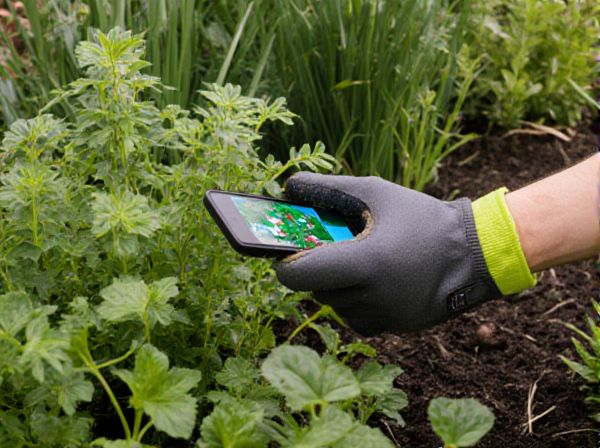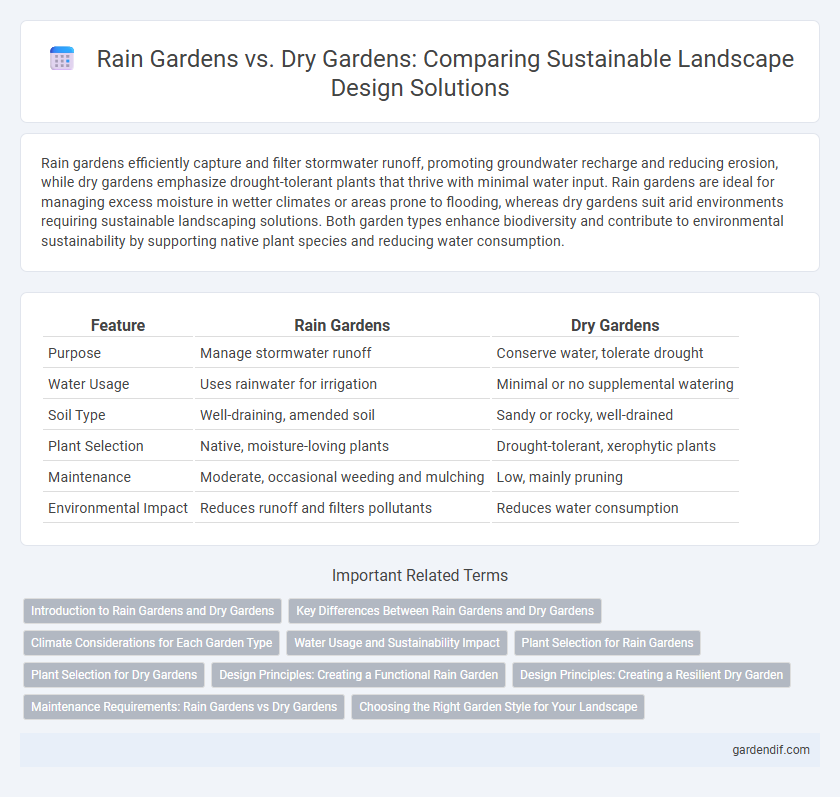
Rain Gardens vs Dry Gardens Illustration
Rain gardens efficiently capture and filter stormwater runoff, promoting groundwater recharge and reducing erosion, while dry gardens emphasize drought-tolerant plants that thrive with minimal water input. Rain gardens are ideal for managing excess moisture in wetter climates or areas prone to flooding, whereas dry gardens suit arid environments requiring sustainable landscaping solutions. Both garden types enhance biodiversity and contribute to environmental sustainability by supporting native plant species and reducing water consumption.
Table of Comparison
| Feature | Rain Gardens | Dry Gardens |
|---|---|---|
| Purpose | Manage stormwater runoff | Conserve water, tolerate drought |
| Water Usage | Uses rainwater for irrigation | Minimal or no supplemental watering |
| Soil Type | Well-draining, amended soil | Sandy or rocky, well-drained |
| Plant Selection | Native, moisture-loving plants | Drought-tolerant, xerophytic plants |
| Maintenance | Moderate, occasional weeding and mulching | Low, mainly pruning |
| Environmental Impact | Reduces runoff and filters pollutants | Reduces water consumption |
Introduction to Rain Gardens and Dry Gardens
Rain gardens are shallow, planted depressions designed to capture and infiltrate rainwater runoff, promoting groundwater recharge and reducing stormwater pollution. Dry gardens, also known as xeriscape gardens, use drought-tolerant plants and efficient irrigation techniques to minimize water use in landscaping. Both garden types enhance sustainable landscape practices by conserving water and improving soil health.
Key Differences Between Rain Gardens and Dry Gardens
Rain gardens are designed to capture and absorb stormwater runoff, utilizing native plants that thrive in wet conditions and improve water quality by filtering pollutants. Dry gardens, also called xeriscapes, prioritize drought-resistant plants and efficient irrigation to conserve water in arid environments. The primary difference lies in water management: rain gardens handle excess water through infiltration, while dry gardens minimize water usage and thrive in dry soils.
Climate Considerations for Each Garden Type
Rain gardens excel in regions with frequent rainfall by effectively capturing and filtering stormwater runoff while promoting groundwater recharge, reducing the risk of flooding and erosion. Dry gardens are ideally suited for arid or drought-prone climates, utilizing drought-tolerant plants and efficient irrigation techniques to conserve water and maintain soil stability. Selecting the appropriate garden type based on local climate conditions enhances sustainability and landscape resilience.
Water Usage and Sustainability Impact
Rain gardens maximize water absorption by capturing and filtering stormwater runoff, reducing the need for supplemental irrigation and mitigating urban flooding effects. Dry gardens utilize drought-tolerant plants and minimal watering, significantly lowering water consumption and promoting sustainable landscaping in arid regions. Both garden types enhance water conservation but differ in their approach, with rain gardens focusing on stormwater management while dry gardens emphasize drought resilience.
Plant Selection for Rain Gardens
Rain gardens require plant selections that tolerate periodic flooding and dry spells, often favoring native species such as sedges, rushes, and swamp milkweed. These plants enhance water absorption, reduce runoff, and support local wildlife habitats. In contrast to dry gardens, rain garden plants must thrive in fluctuating moisture conditions and contribute to the garden's ecological function.
Plant Selection for Dry Gardens
Plant selection for dry gardens emphasizes drought-tolerant species such as succulents, ornamental grasses, and Mediterranean herbs that thrive in low-moisture environments. These plants typically feature deep root systems, waxy or hairy foliage, and efficient water usage adaptations to survive prolonged dry periods. Incorporating native plants like lavender, sage, and yucca enhances resilience while supporting local ecosystems in dry garden landscapes.
Design Principles: Creating a Functional Rain Garden
Rain gardens utilize native plants and strategic soil layers to manage stormwater runoff, promoting infiltration and reducing erosion. Incorporating an impermeable liner beneath a dry garden prevents water accumulation, emphasizing drought-tolerant species adapted to arid conditions. Proper grading and selection of vegetation in rain gardens optimize water absorption while enhancing aesthetics and supporting local biodiversity.
Design Principles: Creating a Resilient Dry Garden
Designing a resilient dry garden involves selecting drought-tolerant plants such as succulents, native grasses, and deep-rooted shrubs that thrive with minimal water. Emphasizing soil amendment with organic matter enhances moisture retention and promotes root health, while incorporating mulch reduces evaporation and regulates soil temperature. Strategic placement of hardscaping elements like gravel paths and stone accents aids in water conservation and creates texture contrast, ensuring both aesthetic appeal and functional sustainability.
Maintenance Requirements: Rain Gardens vs Dry Gardens
Rain gardens require regular maintenance such as weeding, mulching, and checking for proper drainage to ensure plant health and prevent standing water. Dry gardens demand less frequent watering and pruning since they feature drought-tolerant plants adapted to low-moisture conditions. Both garden types benefit from seasonal inspections to manage plant growth and soil quality, but rain gardens typically involve greater upkeep due to water management needs.
Choosing the Right Garden Style for Your Landscape
Rain gardens effectively manage stormwater by capturing runoff and promoting groundwater recharge, ideal for areas with poor drainage or heavy rainfall. Dry gardens thrive in arid climates, utilizing drought-tolerant plants and efficient irrigation to minimize water use and maintain landscape health. Selecting the right garden style depends on local climate, soil conditions, and water availability to ensure sustainable and attractive landscaping.
Rain Gardens vs Dry Gardens Infographic

 gardendif.com
gardendif.com